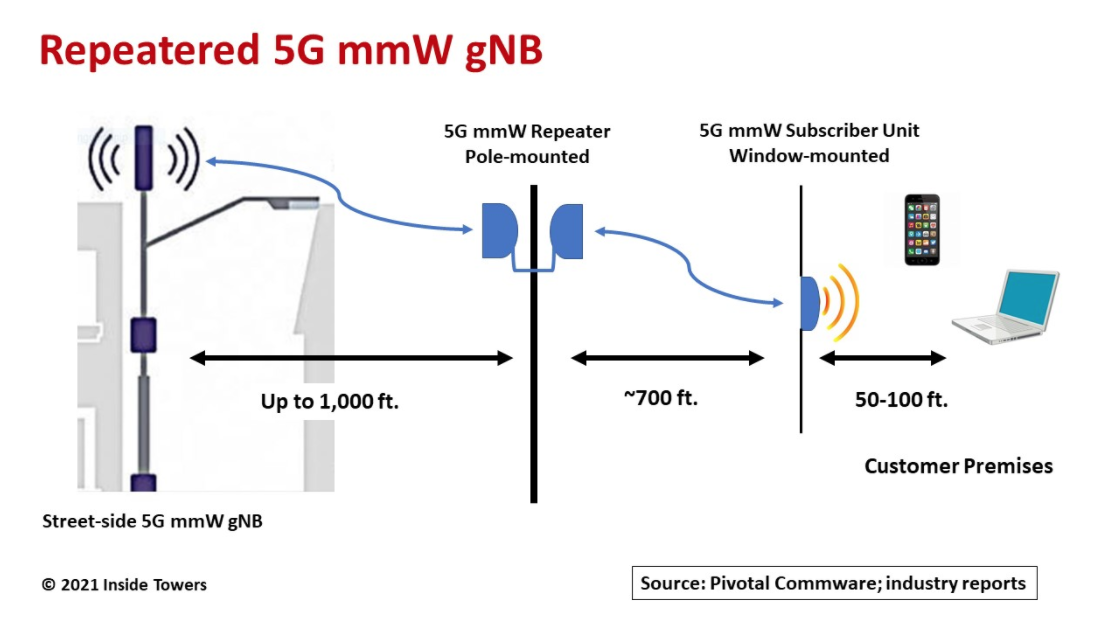Mobile network operators deploying 5G must ensure transmitted signals are widespread enough with adequate signal strength to enable high-speed data throughput and low latency for a variety of uses.
There are limits to RF signal propagation, especially at millimeter wave frequencies. That’s why different frequencies are used for different 5G deployment scenarios.
Low-band 600 or 700 MHz and upper mid-band 2.5 and 3.5/3.7 GHz frequencies offer relatively cheap wide area coverage because signals travel long distances, but capacity is expensive. At channel sizes of 5, 10 or 20 MHz, getting access to enough sub-6 GHz spectrum to create larger channels drives costs up.
With small cells operating in high band mmW frequencies, capacity comparatively is less expensive, on a $/MHz/POP basis, with wide 100+ MHz channels, but coverage becomes expensive since mmW signals do not travel far.
mmW propagation can reach up to 1,000 ft. with clear line of sight transmission but is much shorter than sub-6 GHz low- and mid-band transmissions that travel a mile or more.
To densify their networks, MNOs must deploy many mmW small cells on streetlights, telephone or utility poles, and in some markets, dedicated poles in rights-of-way.
The big hurdle is that these various placements must be approved by local authorities. Moreover, these sites must have access to metered power and a fiber connection.
MNO network designs determine where mmW small cells should be placed for optimal signal range and reach but in locations where power and fiber are available.
In dense neighborhoods, many mmW small cells are needed to reach a target number of households to justify capital expenditures for providing the service. Often, this means overcoming transmission impediments, including odd street layouts, trees, and large buildings.
A solution is low cost, low power repeaters that extend the mmW small cell coverage.
Pivotal Commware, based in Kirkland, WA, is field testing its Pivot 5G™ mmW outdoor repeater and its Echo 5G™ subscriber unit (SU) with Verizon’s 5G Ultra Wideband gNodeB (gNB) base stations at 28 GHz in a fixed wireless access configuration for indoor applications.
Pivotal’s design incorporates its patented Holographic Beam Forming (HBF) technology. HBF is an advance over phased array beamforming techniques using fewer components and less power resulting in lower weight and less cost. Signals radiating from Pivotal’s radios form a “hologram” that can be dynamically tuned to direct signals to targeted areas.
Utilizing its WaveScape network planning tool, Pivotal simulated a deployment scenario in an American urban neighborhood with over 1,400 single homes and multi dwelling units covering roughly a square kilometer. Seven gNBs were placed at strategic locations in the target area with a goal of reaching about 80 percent of the dwellings.
Tests showed that just 18 percent of the dwellings received a viable signal from the seven gNBs. By installing the Echo 5G SU in households that were beyond the current reach of each gNB, in this case a total of 533 SUs, penetration jumped to 55 percent. The SUs boost mmW signals indoors 50-100 ft. to reach 5G-enabled devices.
The next step was to install the Pivot 5G outdoor repeaters to extend signal into areas beyond the gNBs’ reach. Two Pivot 5G units are installed back-to-back to receive, boost and retransmit mmW signals in both the download and upload directions.
The Pivot 5Gs require power but no fiber backhaul connection and are typically mounted on a streetlight where power is readily accessible.
The receiver unit points towards the gNB while the transmitter unit points toward the target neighborhood. Distances in either direction can be 500-1,000 ft providing the received signal strength is at least -100 dBm.
For the simulation, Pivotal’s network planning tool determined that 30 Pivot 5G repeater sites were needed along with another 360 Echo 5G SUs. Once deployed, tests verified that coverage reached 80 percent or nearly 1,200 households in the target area.
The economics of using repeaters and SUs are quite compelling.
To achieve 80 percent coverage without repeaters would have required 28 gNBs. At an installed cost of approximately $65,000 each, a gNB-only solution requires capital expenditures of over $1.8 million or about $1,580 per subscriber. Note that siting, fiber, and installation costs for gNBs can vary depending on the market, potentially increasing the total cost per gNB and per subscriber.
However, with a combination of the seven gNBs, 30 Pivot 5G repeater sites at $5,000 each and a total of 896 Echo 5G SUs at $300 apiece, the capex tallies $873,000 or about $757 per subscriber, a savings of over 50 percent.
Given robust MNO small cell projections, expect repeatered mmW deployments to get closer scrutiny.
By John Celentano, Inside Towers Business Editor





Reader Interactions